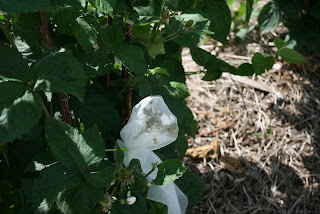I am getting reports of spotted wing drosophila SWD larval activity in some southeastern locations over the past two weeks, and we have observed SWD infestation in some of our research station plots in North Carolina. Infestations in my plots are a good thing, because it allows us to study SWD here and provide you with up to date information, but infestations in grower fields are another matter. We have been catching adult SWD since January in North Carolina, but these are the earliest larval infestations we have recorded in the state. This early activity has prompted several questions about what growers or homeowners should do if they find SWD infested fruit. Here's a quick summary of the four key steps you should take in the event of SWD infestation:
1. Remove all ripe and ripening fruit and destroy it (by freezing, "baking" in the sun inside a clear plastic bag for a few days, or removing from the site). Eggs or larvae may be present in otherwise sound appearing fruit. Leaving this fruit means that potentially infested fruit is present and could be harvested.
2. Begin an aggressive (once per week if it does not rain, reapplication in the event of rain) spray program. Rotating between at least two modes of action will reduce the likelihood of resistance development. See
herefor information about the probably efficacy of registered insecticides in southeastern small fruit crops. Because these efficacy ratings are based on work done largely in the western US, where environmental conditions differ, they are not set in stone. We are running several efficacy trials as I type and hope to have NC specific data by mid summer.
3. Practice excellent sanitation. Remove all ripe fruit and sell or destroy it. Do not discard culls in the field, and clean up after rain and u-pickers. Unpicked fruit is a reservoir for SWD larvae.
4.定期采样果实并考虑捕获苍蝇。陷阱告诉您SWD的存在或缺席,并不完美,但它们很有帮助。将陷阱放在草莓行中,靠近水果,以便最佳机会捕获苍蝇。通过将它们切开并寻找幼虫,将它们粉碎在盐水中(每加仑1/4杯盐)或冷冻它们来品尝水果。盐水和冷冻会导致幼虫退出果实。每个场采样至少30个浆果。看
hereand
herefor trapping information and
here用于幼虫抽样信息。
All growers are strongly encouraged to monitor for SWD adults
beforelarvae are found. If adults are present and fruit are ripe, pesticide treatments are recommended through the end of harvest. We hope that this strategy will prevent larvae from showing in fruit and triggering the actions listed here.
Update, June 22, 2012
我知道房主可能无法或不希望在花园中的水果上使用杀虫剂是院子里。不幸的是,仅卫生设施就不会消除和SWD人口。但是,如果您可以更早地选择水果或更少成熟的水果,它将以更少的时间暴露于SWD,并且可能会处于较低的侵扰风险。同样重要的是要注意,尽管SWD幼虫会使水果更快地腐烂,并且如果存在于水果中,但它们不是有毒或寄生的。如果您无意中从家族花园中食用了SWD幼虫已经存在的水果,它们不会带来健康风险。
Update, August 7, 2012
I have been reading LOTS of scientific papers about SWD in the last week. A couple of Japanese references suggest that mesh cages or bags (specifically 0.98mm mesh) prevented SWD infestation in blueberries without impacting plant growth. We use mesh bags a lot to either keep insects we are studying in or to keep insects we don't want out.
 |
| 我们已经使用黑莓中的网状袋来排除蓟马开发水果,以确定它们是否影响水果的发展。他们似乎没有。 |
对于可以容忍植物袋的房主来说,这种策略值得一试。为了排除SWD,应在水果开始改变颜色并紧密密封之前放置笼子。我们通常会在笼子和植物的茎之间放置一块缝泡沫,以使我们能够紧紧绑住笼子(用拉链领带或麻线),但可以保护茎免受损坏。笼子应保持到位,直到收获水果为止。我们使用织物商店中的机构网眼并将笼子缝到尺寸上,但是油漆滤器也可以捏合。我计划明年使用我的后院蓝莓,黑莓和无花果尝试这种方法,并有兴趣听到其他人是否也试用它。

